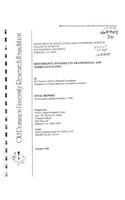
Disturbance Dynamics in Transitional and Turbulent Flows
Series:
In order to expand the predictive capability of single-point turbulence closure models to account for the early-stage transition regime, a methodology for the formulation and calibration of model equations for the ensemble-averaged disturbance kinetic energy and energy dissipation rate is presented. First the decay of laminar disturbances and turbulence in mean shear-free flows is studied. In lami
NaN
VOLUME
English
Paperback

In order to expand the predictive capability of single-point turbulence closure models to account for the early-stage transition regime, a methodology for the formulation and calibration of model equations for the ensemble-averaged disturbance kinetic energy and energy dissipation rate is presented. First the decay of laminar disturbances and turbulence in mean shear-free flows is studied. In laminar flows, such disturbances are linear superpositions of modes governed by the Orr-Sommerfeld equation. In turbulent flows, disturbances are described through transport equations for representative mean quantities. The link between a description based on a deterministic evolution equation and a probability based mean transport equation is established. Because an uncertainty in initial conditions exists in the laminar as well as the turbulent regime, a probability distribution must be defined even in the laminar case. Using this probability distribution, it is shown that the exponential decay of the linear modes in the laminar regime can be related to a power law decay of both the (ensemble) mean disturbance kinetic energy and the dissipation rate. The evolution of these mean disturbance quantities is then described by transport equations similar to those for the corresponding turbulent decaying flow. Second, homogeneous shear flow, where disturbances can be described by rapid distortion theory (RDT), is studied. The relationship between RDT and linear stability theory is exploited in order to obtain a closed set of modeled equations. The linear disturbance equations are solved directly so that the numerical simulation yields a database from which the closure coefficients in the ensemble-averaged disturbance equations can be determined.Grosch, Chester E.Langley Research CenterPERTURBATION THEORY; DISTORTION; TRANSITION FLOW; TURBULENT FLOW; CLOSURE LAW; LAMINAR FLOW; SHEAR FLOW; ORR-SOMMERFELD EQUATIONS; ENERGY DISSIPATION; KINETIC ENERGY; LINEAR EQUATIONS; MATHEMATICAL MOD...
Price Comparison [India]
In This Series
Bestseller Manga
Trending NEWS




















